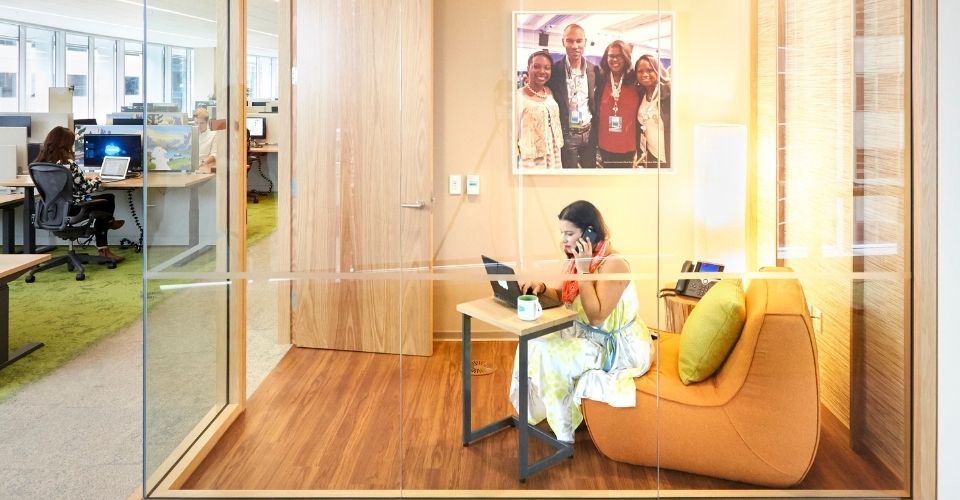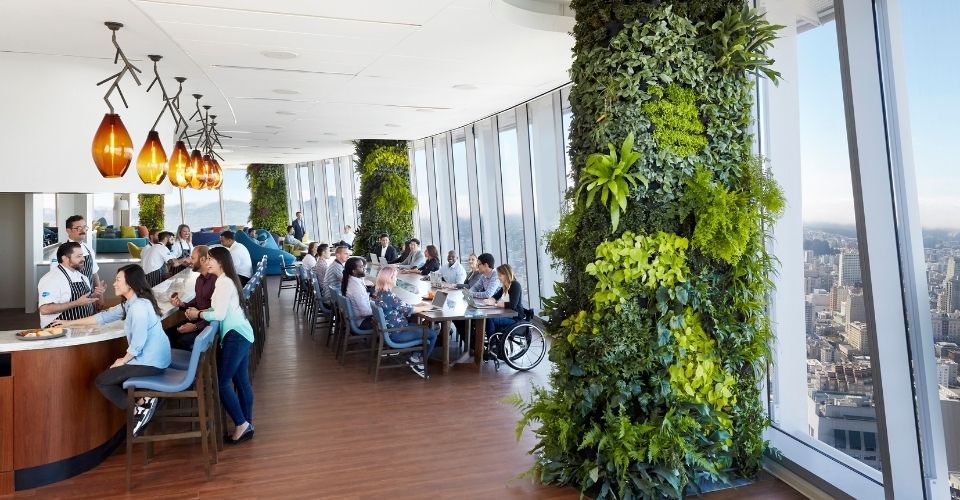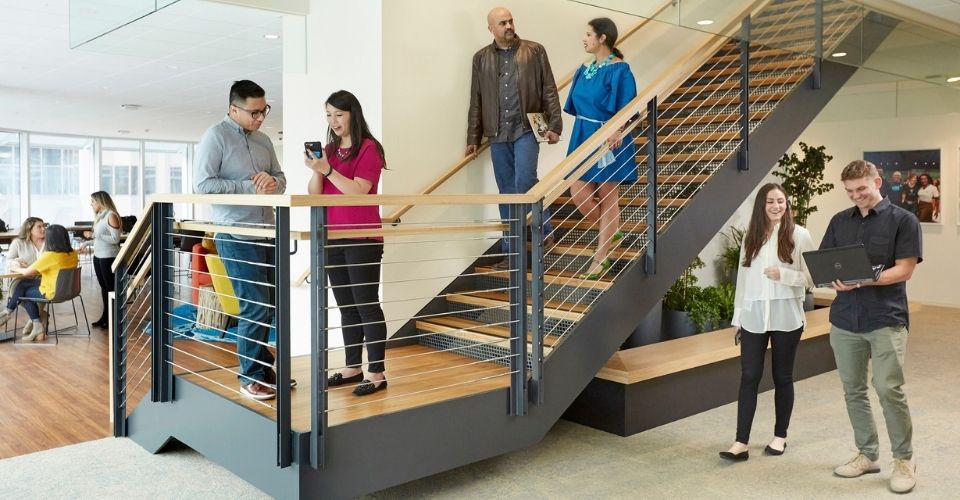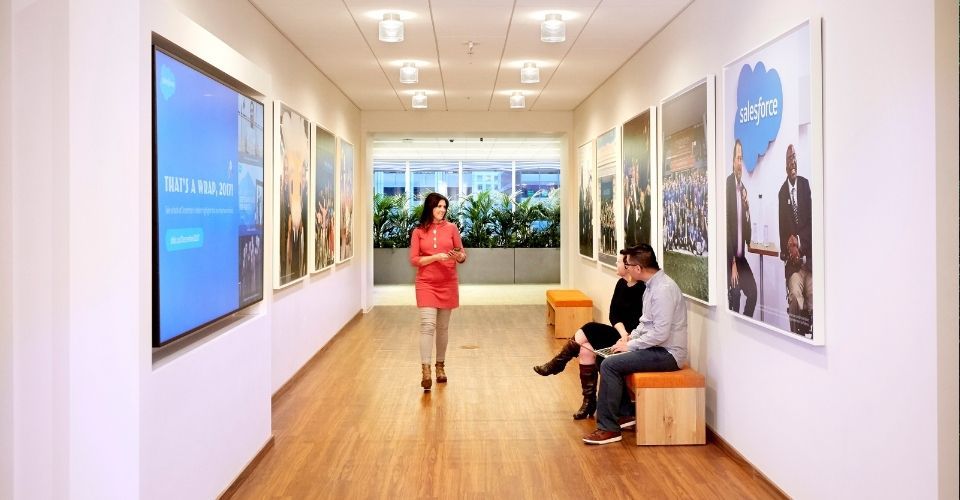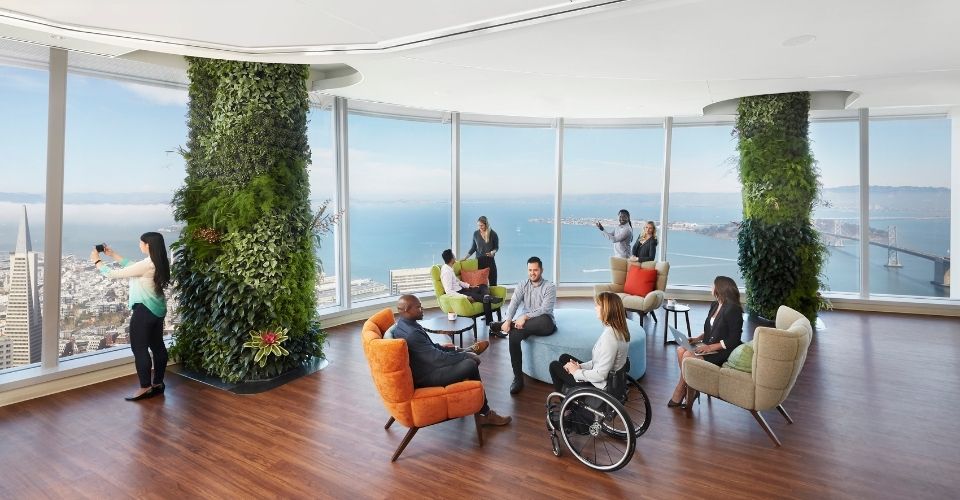In September 2021, Salesforce announced it reached net zero emissions across its entire value chain and achieved 100% renewable energy for its global operations. This announcement came well ahead of its projected goal of 2030.
Reducing infrastructure emissions was a key area of focus for achieving Salesforce’s net-zero goal. To help it get there, the company created the Salesforce Healthy and Sustainable Materials Program in 2016. The purpose of this program was to gain deeper insight into the environmental and health impacts of the building products in Salesforce’s real estate spaces and find opportunities for improvement. Salesforce then used these findings to create a Global Design Standard that promotes a healthy working environment while also reducing its carbon footprint across its entire real estate portfolio.
Following this extensive research, Salesforce selected Interface products as the flooring standard for its global real estate portfolio.
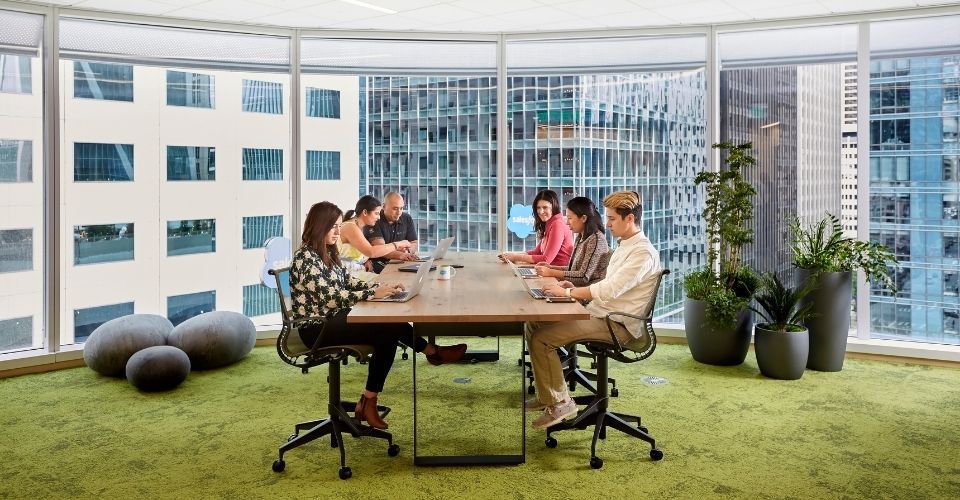
Image courtesy of Salesforce.
Sustainability-Forward Culture Leads to Sustainability-Forward Design
While Salesforce already established a set of design standards, the inclusion of data from the Healthy and Sustainable Materials Program created an opportunity to ingrain the company’s commitment to sustainability and wellness more deeply into every aspect of its business.
“We kind of went at it backward,” Melanie Lowe, Salesforce Director of Global Workplace Design, explained of the process. “We already had our standards in place, and we had just changed up the design, so we then had to turn around and measure all of the design choices we’d made to see if they stood up to our new carbon requirements – and it turns out for the most part they did.”
“We were going for a design that felt very warm and residential,” said Lowe. “This included using a lot of natural elements like oak and real plants in our spaces. Even the Interface grass patterned carpet tile was originally selected for how it looked. We didn’t call it biophilic design at the time, but it was the right choice to make.”
Biophilic design is a holistic design concept that brings the experience of being outdoors into the interior space. Not only do these elements make for a beautiful design, but they also have a direct correlation with improved health, wellbeing, and productivity.
“It was very serendipitous that the design team made all of these aesthetic choices, and then they turned out to be all very high quality,” said Amanda von Almen, Salesforce Head of Sustainable Built Environment. “It made the review process for us on the Healthy Materials side pretty easy.”
Image courtesy of Salesforce.
Image courtesy of Salesforce.
Image courtesy of Salesforce.
Image courtesy of Salesforce.
Image courtesy of Salesforce.
The Intersection of Design, Sustainability and Performance
Fast forward to the present day, and the Design and Healthy Materials teams have their process for selecting new materials down to a science.
“We came up with a three-legged stool model where design, aesthetic, and function are one leg; sustainability and healthy materials are another; and then, pricing, logistics, etcetera are the last leg,” explained Lowe. “And when we go to market with an RFP for a product or material, we want that stool to be in balance.”
An example of this practice is the selection of Interface luxury vinyl tile (LVT).
To help set standards for its Healthy Materials Program, von Almen and her team created a healthy material scoring tool to gain an overhead view of the many different building products and how they measured against each other in terms of sustainability, occupant and worker health, and several other important markers.
“The original LVT product we selected was very low scoring on our healthy material tool; vinyl is typically a low scoring product environmentally,” explained Lowe, “But the leg of the stool that won out was performance. We needed something durable for our high-traffic areas, so we stayed with LVT. However, in using the scoring tool, we realised we had a chance to select an LVT product that was better scoring across the board, so we went with Interface.”
Reducing Embodied Carbon
Since Salesforce integrated healthy and sustainable materials into its Global Design Standard, it has seen significant progress toward its sustainability goals. One of the biggest objectives in creating this standard was to address embodied carbon emissions. For finishing materials, Salesforce looks at emissions from cradle-to-gate or from raw material extraction through manufacturing.
“We’ve already seen a 20% reduction [in embodied carbon] from our baseline,” reported von Almen. “The very low embodied carbon value of Interface carpet is a significant contributing factor to that.”
“We have the lowest embodied carbon footprint in the industry. “This means you can’t find carpet tile with a lower carbon footprint than our standard carpet tile,” said Lisa Conway, Americas VP of Sustainability at Interface.
Salesforce has taken its commitment to reduce embodied carbon even further with the inclusion of its Sustainability Exhibit in all future supplier contracts. This requires any vendors working with Salesforce to make certain climate commitments and set science-based targets by 2024.
“Like Interface, Salesforce knows that the impact of our influence is larger than the impact of our single organisation. When we created the open-source Sustainability Exhibit to accompany our vendor contracts, it wasn’t surprising that Interface was one of the first vendors to sign it – even though they already had a contract in place,” said Gordon L’Estrange, Salesforce VP of Global Real Estate.
“There’s a very clear values alignment between our organisations, and we love that,” said von Almen. “Interface never shies away when we tell them we need to go bolder for making a product more sustainable. I think it’s a fantastic partnership to continue.”
